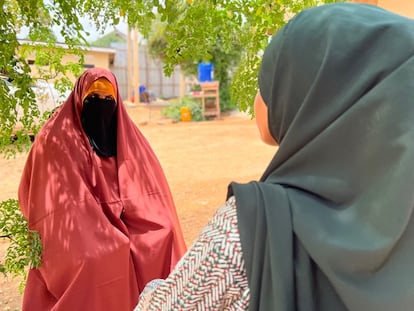Shunned and homeless: Living with HIV in Somalia
With an infrastructure destroyed by more than three decades of conflict, limited funding and such immense stigma against the disease, the challenges are immense

“My nine children and I have been evicted from 10 properties so far,” says Ruun* who lives in the port city of Kismayo in southern Somalia. “As soon as my landlords discover I am HIV positive they throw me out.” She was infected with the virus two years ago by her husband who had another wife. Both of them have died as a result of the disease.
Ruun survives by taking antiretrovirals which she obtains for free from a local hospital. She is one of the lucky ones. According to the World Health Organisation free medication is only available in 17 health facilities across the whole country. The government is planning to open six more by the end of this year.

Hospitals refuse to treat patients
Prejudice against the disease is very high, with some hospitals refusing to treat people who are HIV positive. Private hospitals and pharmacies avoid stocking HIV/AIDs medication for fear that they will lose clients who do not want to have anything whatsoever to do with the disease.
The HIV programme manager at the Ministry of Health, Dr Sadia Abdisamad Abdulahi, says stigma reduction training for medical staff in public hospitals has significantly reduced prejudice. Now the ministry is training health workers in private facilities.
Some media channels refuse to run HIV and AIDS awareness campaigns because they do not want to be associated with the disease.
Ruun’s experience is typical of Somalis known to be infected with the virus. When her family discovered she had the disease, they chased her and her children from their home. “We have been completely removed from their lives,” she says.
Like so many other HIV positive people in Somalia, Ruun has suffered immense discrimination at work. She earns money to try to support her large family by washing clothes. Every morning she travels to work in faraway villages where people do not know she has the virus. She earns about €5 a day.
“When people find out I have the disease, they tell me never to work for them again and to leave the area immediately. I was even detained by the police because of my status.”
Children abused in the streets
Ruun’s children also suffer discrimination. They are insulted in the streets and nobody wants to play with them even though they do not have the virus. Their education has been badly disrupted because they have had to move home so many times due to the evictions. Some of the older children regularly miss school because they have to look after their younger siblings while their mother hunts for work.
Life is equally hard for 75-year-old Khalif Farah Shuriye who lives on the streets of Mogadishu. He caught HIV from his wife after she was raped by armed men in 2012. She later died of the disease.
Like Ruun, he has been rejected by his family and his community. He lives in a small, flimsy shelter he has built for himself on the roadside. It is made from sticks, old clothes and ripped plastic.
Khalif used to earn a living working as a porter in the city’s main commercial area known as Bakara Market. Now he is completely dependent on begging for handouts but they are not enough for him to meet his nutritional needs, an essential part of trying to stay healthy while living with HIV.
Days without water
“When I ask people for help, they run away from me because they think they will catch the disease just by being near me, which is not the case. They shout insults at me.”
Sometimes people give Khalif a kilo of rice, which keeps him going for a few days. Sometimes they give him a few Somali shillings, which he uses to buy a cup of tea.
There are times when he cannot afford to buy water. “Some nights I go to sleep without having had any water the whole day because I simply don’t have any money.”
Like Ruun, Khalif has been able to access antiretrovirals which he receives for free from Mogadishu’s Benadir Hospital, although he says he does not always take them regularly. According to UNAIDS, 50% of adults and children known to be infected with HIV were receiving antiretrovirals in 2021.
Hiding their faces
So intense is the stigma against those living with HIV and AIDS in Somalia that people are terrified of disclosing their status or even seeking life-saving treatment because they don’t want to risk others seeing them taking the medication.
Some of those who do seek treatment hide their faces when they go to hospital to receive care and medication. Women wear the full face veil or niqab; men use scarves. In Benadir hospital in the capital Mogadishu, nurses call patients by numbers, not their names, in order to protect their identities.
When people fall sick with symptoms of the disease, they often shy away from taking an HIV test, preferring ignorance about their status to the prejudice they fear they will face.
Somalis’ reluctance to test for HIV not only means they miss out on treatment; it also makes it difficult to obtain accurate statistics about the rates of infection. According to UNAIDS, 7,700 adults and children were estimated to be living with HIV in Somalia in 2021, which is less than .0005% of the population.
It might be more helpful to consider the prevalence of HIV among prisoners, more of whom receive routine testing. According to UNAIDS the rate was 0.4% in 2019. Pregnant women are also tested more regularly. Dr Abdulahi says that in 2017, average HIV antenatal prevalence across Somalia was less than 0.1%.
She warns that the recent growth of drug abusers who inject themselves with opioids is putting a new group of Somalis at increased risk of catching the virus.
Since 2009, Somalia has developed four strategic frameworks for dealing with the disease and aims to eliminate HIV and AIDs from the country by 2030. But with an infrastructure destroyed by more than three decades of conflict, limited funding and such immense stigma against the disease, the challenges are immense.
*Ruun is not her real name, which has been changed to protect her identity.
Tu suscripción se está usando en otro dispositivo
¿Quieres añadir otro usuario a tu suscripción?
Si continúas leyendo en este dispositivo, no se podrá leer en el otro.
FlechaTu suscripción se está usando en otro dispositivo y solo puedes acceder a EL PAÍS desde un dispositivo a la vez.
Si quieres compartir tu cuenta, cambia tu suscripción a la modalidad Premium, así podrás añadir otro usuario. Cada uno accederá con su propia cuenta de email, lo que os permitirá personalizar vuestra experiencia en EL PAÍS.
¿Tienes una suscripción de empresa? Accede aquí para contratar más cuentas.
En el caso de no saber quién está usando tu cuenta, te recomendamos cambiar tu contraseña aquí.
Si decides continuar compartiendo tu cuenta, este mensaje se mostrará en tu dispositivo y en el de la otra persona que está usando tu cuenta de forma indefinida, afectando a tu experiencia de lectura. Puedes consultar aquí los términos y condiciones de la suscripción digital.
More information
Archived In
Últimas noticias
Aquilino Gonell, former Capitol sergeant: ‘If it hadn’t been for the police, the US would be a dictatorship’
A hybrid building: Soccer pitch, housing, and a shopping mall
Europe urges Trump to respect Greenland following annexation threats
Science seeks keys to human longevity in the genetic mixing of Brazilian supercentenarians
Most viewed
- Alain Aspect, Nobel laureate in physics: ‘Einstein was so smart that he would have had to recognize quantum entanglement’
- Mexico’s missing people crisis casts a shadow over World Cup venue
- Why oil has been at the center of Venezuela-US conflicts for decades
- Alvin Hellerstein, a 92-year-old judge appointed by Bill Clinton, to preside over Maduro’s trial in New York
- Cuba confirms death of 32 of its citizens in the US attack against Venezuela










































